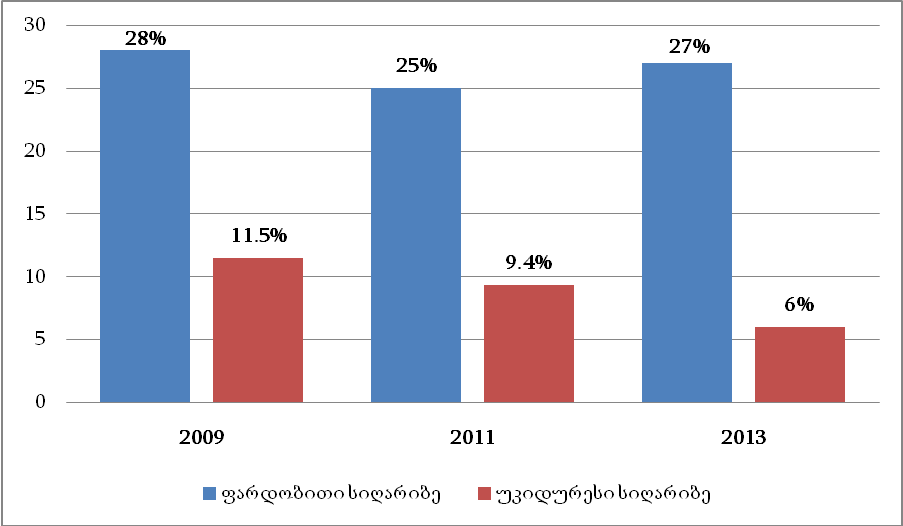On 1 December 2014, a seminar organised by the World Bank and UNICEF was held in Tbilisi. The problems connected to the reduction of poverty and appropriate strategies were discussed during the seminar. The Minister of Labour, Health and Social Affairs of Georgia also participated in the aforementioned seminar. Davit Sergeenko stated: “Child poverty is a problematic issue for many countries. According to recent studies, the child poverty level has increased in European countries. The dynamics in Georgia has changed and child poverty has decreased.”
We took interest in child poverty levels in Georgia and verified the accuracy of Mr Sergeenko’s statement.
A recent UNICEF study on child poverty in Georgia presents data from the year 2013. The study has not yet been published but information about its results can be found in UNICEFpress releases. We also checked the 2013 child poverty levels with the Head of UNICEF’s Social Policy Programme, Tina Baum.
The number of children in poverty in Georgia increased by 2% in 2013 and reached 27%. However, the number of children living in extreme poverty decreased from 9.4% to 6% in the past two years. The child poverty level in Georgia is quite high with 225,000 children living below the poverty line and spending less than GEL 4.5 daily whilst more than 50,000 children are living in extreme poverty, consuminglessthan GEL 2 per day.
It should be noted that the Ministry of Health, Labour and Social Affairs of Georgia, with UNICEF’s help, has already created a new methodology for assessing the socio-economic conditions of the socially vulnerable families. This methodology includes UNICEF’s recommendation of granting socially vulnerable families an additional GEL 10 for each child.
UNICEF publishes its studies on child poverty every two years. Hence, we can compare the statistics of 2013 to those of 2011. Both marginal and relative child poverty levels decreased in 2011. In 2013, however, the relative child poverty increased whilst the marginal poverty decreased (see Chart 1).
Chart 1:Child Poverty Level from 2009 to 2013 (%)
In his statement, Davit Sergeenko also talked about the increase of child poverty in European countries. We checked this information based upon the data of Eurostat.
The official statisticsof Eurostat shows the percentage of children from 0-16 years who are at a risk of poverty. The child poverty risk level has been increasing in European Union member states and the Eurozone from 2009 to 2012; however, it decreased slightly in 2013. The same trend has been observed in most European countries. However, some European countries have seen the child poverty risk increase in 2013 as well. Despite the fact that there is a high percentage of children at a risk of poverty in European countries, comparing them to Georgia is still inappropriate as the relative poverty is determined based upon the average consumption. Average consumption is much higher in European countries than it is in Georgia.
|
Child Poverty Levels in Europe |
|||||
|
|
2009 |
2010 |
2011 |
2012 |
2013 |
|
EU Member States |
23.3% |
23.8% |
24.4% |
24.8% |
24.5% |
|
Eurozone |
21.5% |
21.9% |
23% |
23.4% |
23% |
|
Belgium |
20.2% |
20.8% |
21% |
21.6% |
20.8% |
|
France |
18.5% |
19.2% |
19.3% |
19.1% |
18.1% |
|
Estonia |
23.4% |
21.7% |
23.1% |
23.4% |
23.5% |
|
Greece |
27.6% |
27.7% |
31.0% |
34.6% |
35.7% |
|
Italy |
24.7% |
24.5% |
28.2% |
29.9% |
28.4% |
|
Latvia |
37.9% |
38.2% |
40.1% |
36.2% |
35.1% |
Conclusion
According to UNICEF’s study on child poverty, the issue of poverty among children still remains one of the significant challenges for Georgia. According to the data of 2013, the child poverty level increased from 25% to 27%. However, the number of children living in extreme poverty decreased.
In his statement, the Minister underlined that the child poverty dynamics started to decrease in 2013. UNICEF conducts its studies on child poverty every two years. According to the previous study, both marginal and relative child poverty levels decreased in 2011. Hence, child poverty increased in 2013 and did not decrease as stated by the Minister; however, the trend of a reduction of marginal poverty continued in 2013 as well.
The Minister also said in his statement that the level of child poverty in European countries is on the rise. The child poverty risk level in European Union member states increased from 2009 to 2012 but started to decrease in 2013. The child poverty level has in fact increased in some European countries but the risk of poverty is being decreased in most. In addition, it is inappropriate to compare the poverty levels of European countries to that of Georgia as the average consumption is much higher in Europe than it is in Georgia.
FactCheckconcludes that Davit Sergeenko’s statement: “The dynamics in Georgia has changed and child poverty has decreased,” isMOSTLY FALSE.










